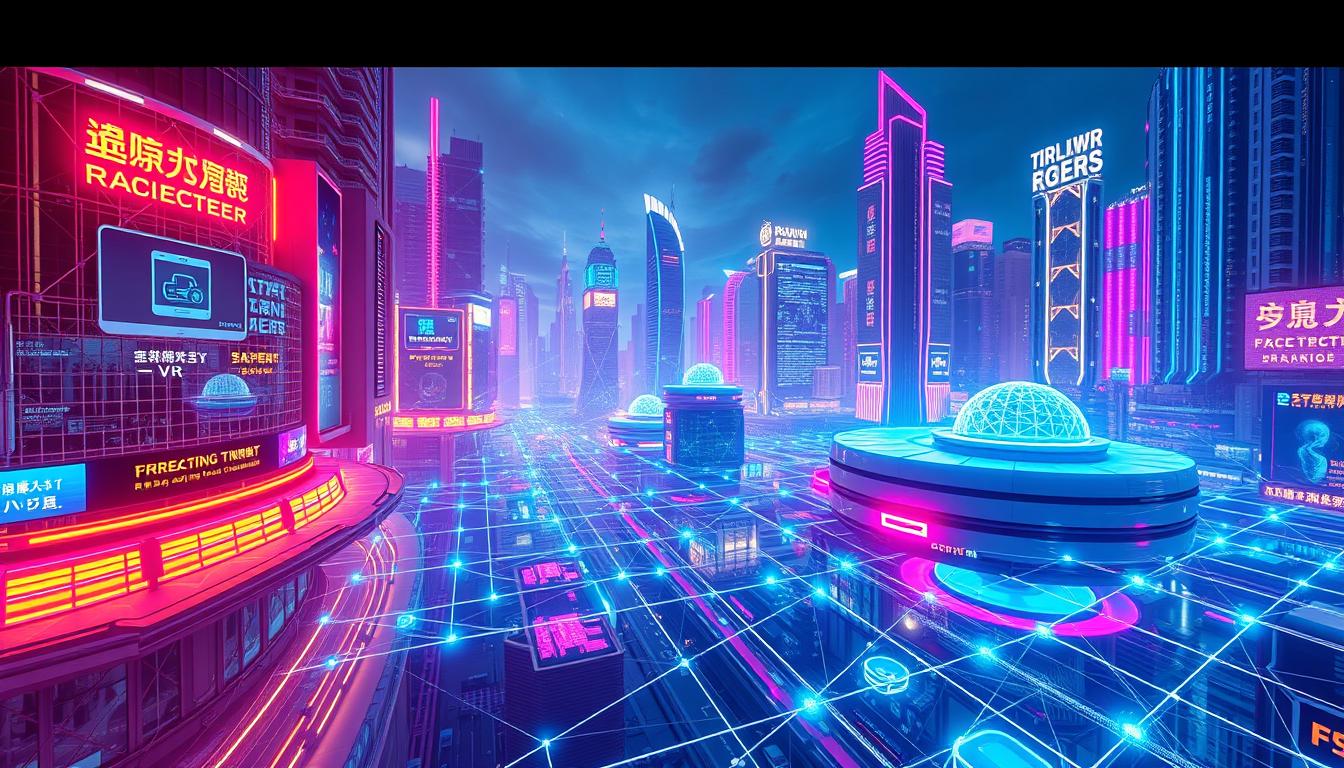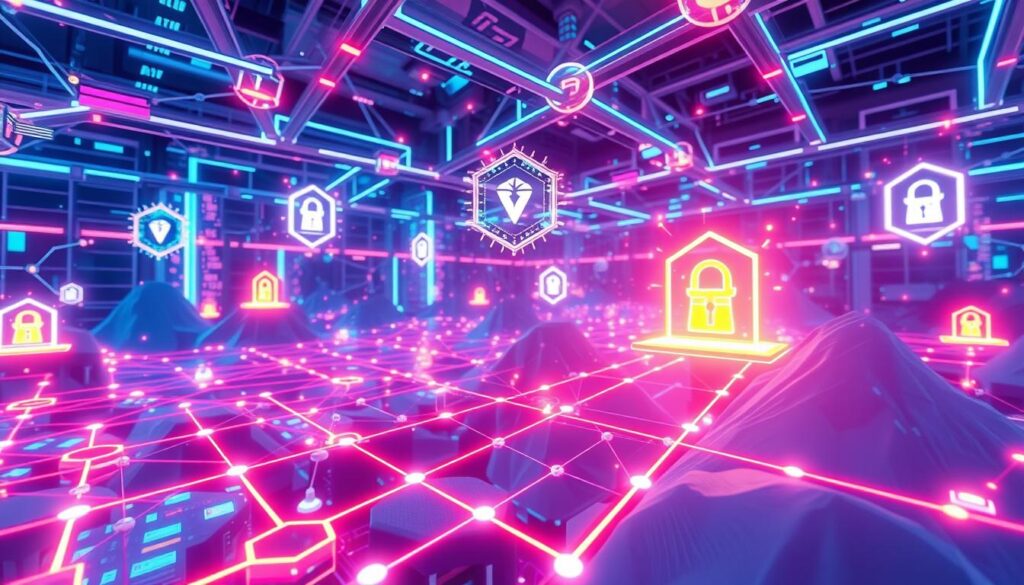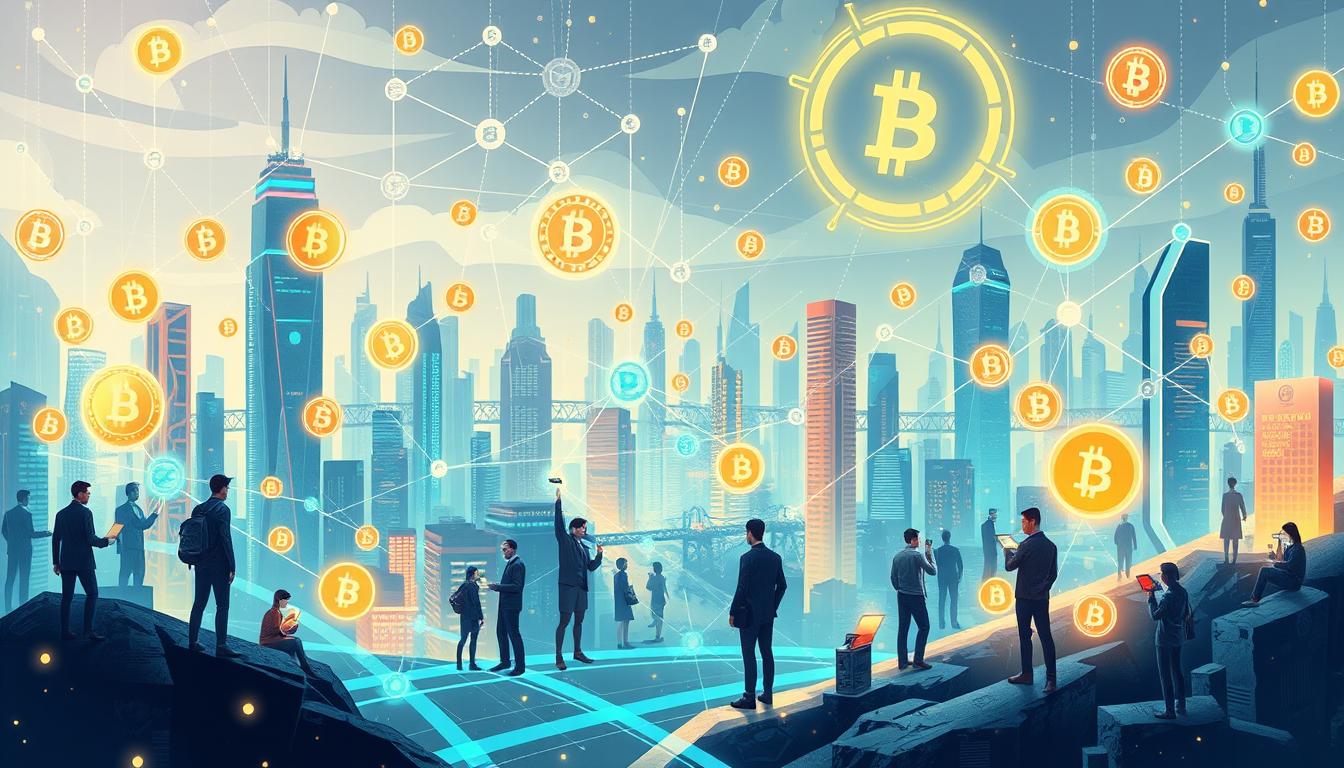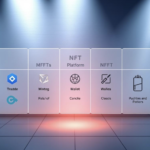Now Reading: Blockchain for Virtual Reality Integration Guide 2024
- 01
Blockchain for Virtual Reality Integration Guide 2024
Blockchain for Virtual Reality Integration Guide 2024

As the world eagerly embraces the convergence of cutting-edge technologies, the integration of blockchain and virtual reality (VR) is poised to revolutionize the way we experience and interact with digital environments. This comprehensive guide delves into the synergies between blockchain and VR, exploring how this powerful combination can enhance immersive experiences, foster decentralized ecosystems, and unlock unprecedented opportunities for users and developers alike.
The rapid advancements in VR technology have paved the way for an increasingly immersive and interactive digital landscape, allowing users to explore and engage with virtual worlds like never before. However, the traditional centralized model of VR has often posed challenges in terms of security, data ownership, and transparency. This is where blockchain, with its decentralized, secure, and transparent nature, steps in to transform the VR landscape.
By integrating blockchain technology into VR applications, users can benefit from enhanced security measures, decentralized ownership of digital assets, and increased transparency in transactions and content distribution. This integration not only empowers individuals but also enables the creation of thriving, community-driven virtual economies that unlock new possibilities for monetization, content creation, and user engagement.
Key Takeaways
- Blockchain technology can enhance the security, transparency, and decentralization of virtual reality ecosystems.
- Integrating blockchain in VR enables users to own and control their digital assets, creating new opportunities for monetization and content creation.
- Blockchain-powered VR applications can foster thriving virtual economies, where users can engage in play-to-earn gaming models and participate in the ownership of virtual real estate.
- The synergy of blockchain and VR presents exciting use cases, such as digital identity management, avatar verification, and the creation of unique virtual assets.
- Developers and industry leaders are actively exploring technical frameworks and tools to seamlessly integrate blockchain technology into VR applications, addressing challenges related to scalability and user experience.
Introduction to Blockchain and Virtual Reality
As the digital landscape continues to evolve, the synergy between blockchain technology and virtual reality (VR) is becoming increasingly important. This section provides an overview of these two transformative technologies and explores how they can work in tandem to create new possibilities for Cryptographic Asset Ownership, Metaverse Infrastructure, and Distributed VR Applications.
Overview of Blockchain Technology
Blockchain is a decentralized, distributed digital ledger that records transactions across many computers in a network. It is known for its security, transparency, and immutability, making it a powerful tool for various industries, including finance, supply chain management, and identity verification. The blockchain’s ability to facilitate secure and transparent data exchange is a key aspect of its potential integration with VR.
Understanding Virtual Reality
Virtual reality is an immersive, computer-generated environment that simulates a 3D world, allowing users to interact with digital objects and environments in a highly realistic manner. VR technology has seen significant advancements in recent years, with the rise of affordable and accessible headsets, enabling a wider adoption of Distributed VR Applications across gaming, entertainment, and enterprise sectors.
The Synergy of Blockchain and VR
The combination of blockchain and VR presents exciting opportunities for the future of digital experiences. Blockchain can provide the necessary infrastructure for secure Cryptographic Asset Ownership and transparent transactions within virtual environments, empowering users with true digital ownership and control over their Metaverse Infrastructure. This integration can lead to the development of decentralized VR platforms, enabling new models for virtual economies, gaming, and social interactions.
| Blockchain Technology | Virtual Reality |
|---|---|
| Decentralized digital ledger | Immersive computer-generated environments |
| Secure and transparent data exchange | Realistic and interactive digital experiences |
| Enables Cryptographic Asset Ownership | Supports Distributed VR Applications |
| Provides Metaverse Infrastructure | Empowers virtual economies and social interactions |
By leveraging the strengths of both blockchain and VR, developers and entrepreneurs can create innovative solutions that redefine the way we interact with digital environments and assets, paving the way for a more secure, transparent, and user-centric Metaverse Infrastructure.
Benefits of Integrating Blockchain in VR
As the virtual reality (VR) industry continues to evolve, the integration of blockchain technology offers numerous advantages that can transform the way users interact within NFT Virtual Environments. By leveraging the inherent properties of blockchain, VR platforms can enhance security, empower users, and foster greater transparency.
Enhanced Security Measures
Blockchain’s decentralized nature and cryptographic security protocols provide a robust shield against cyber threats in Consensus-Based VR Platforms. The immutable ledger and distributed consensus mechanisms ensure that data and transactions within Peer-to-Peer VR Networks are safeguarded from unauthorized access or tampering, instilling a heightened sense of trust and reliability for users.
Decentralization and User Ownership
One of the key benefits of blockchain integration in VR is the ability to grant users true ownership over their digital assets and experiences. By leveraging blockchain-based smart contracts, users can securely own, trade, and monetize their virtual items, avatars, and even virtual real estate, empowering them to participate in the digital economy on their own terms.
Increased Transparency and Trust
Blockchain’s transparency and immutability can significantly enhance trust within virtual environments. All transactions, ownership records, and interactions are transparently recorded on the blockchain, providing a clear and verifiable audit trail. This level of transparency helps to foster a more trustworthy and secure ecosystem for Peer-to-Peer VR Networks, where users can engage with confidence.
| Benefit | Description |
|---|---|
| Enhanced Security | Blockchain’s decentralized nature and cryptographic protocols safeguard data and transactions in VR platforms. |
| User Ownership | Blockchain-based smart contracts enable users to own, trade, and monetize their virtual assets and experiences. |
| Increased Transparency | Blockchain’s immutable ledger provides a clear and verifiable audit trail, fostering trust within virtual environments. |
“Blockchain technology has the potential to revolutionize the virtual reality industry, providing a secure, decentralized, and transparent foundation for the next generation of immersive experiences.”
Key Use Cases of Blockchain in Virtual Reality
As the convergence of Blockchain and Virtual Reality (VR) continues to evolve, a myriad of intriguing use cases are emerging that showcase the synergy between these transformative technologies. Let’s explore some of the key applications that are driving the integration of Blockchain within immersive VR ecosystems.
Virtual Real Estate and Ownership
One of the most compelling use cases of Blockchain in VR is the ability to establish a decentralized system of virtual real estate and asset ownership. By leveraging Blockchain’s tamper-resistant ledger, users can securely purchase, own, and trade virtual properties and goods within VR environments. This unlocks a new dimension of digital economies, where users can truly own and control their virtual assets, fostering a new era of Blockchain for Virtual Reality Integration.
Play-to-Earn Gaming Models
The integration of Blockchain in VR has given rise to innovative gaming models that seamlessly blend entertainment with economic incentives. In these Decentralized VR Ecosystems, players can earn cryptocurrencies or other digital assets by participating in various in-game activities, creating a “play-to-earn” paradigm that revolutionizes the way we think about virtual gaming. This approach not only enhances player engagement but also fosters the development of Immersive Experiences that blur the lines between the virtual and the physical worlds.
Digital Identity and Avatar Verification
Blockchain technology also offers a robust solution for managing digital identities and verifying avatars within VR environments. By leveraging Blockchain-based identity systems, users can create secure and unique digital personas that can be authenticated across different VR platforms. This not only enhances user privacy and security but also enables seamless cross-platform Immersive Experiences where users can maintain a consistent digital identity.
| Use Case | Description | Key Benefits |
|---|---|---|
| Virtual Real Estate and Ownership | Decentralized system for purchasing, owning, and trading virtual properties and assets within VR environments | Secure ownership, transferability, and monetization of digital assets |
| Play-to-Earn Gaming Models | Blockchain-powered gaming ecosystems that allow players to earn cryptocurrencies or digital assets through in-game activities | Increased player engagement, economic incentives, and the blending of virtual and physical economies |
| Digital Identity and Avatar Verification | Blockchain-based identity systems for creating secure and unique digital personas that can be authenticated across VR platforms | Enhanced user privacy, security, and seamless cross-platform experiences |
These are just a few examples of the transformative use cases that are driving the integration of Blockchain and Virtual Reality. As the technology continues to evolve, we can expect to see even more innovative applications that further blur the lines between the virtual and physical worlds.

Technical Frameworks for Integration
As the virtual reality (VR) landscape continues to evolve, the integration of blockchain technology has become a crucial aspect of developing robust and secure VR applications. From Cryptographic Asset Ownership to enabling Metaverse Infrastructure and Distributed VR Applications, blockchain offers a myriad of technical frameworks that can revolutionize the VR ecosystem.
Smart Contracts in VR Applications
One of the key blockchain-based technologies that are transforming VR is the use of smart contracts. These self-executing digital contracts allow for the seamless management of virtual asset ownership, transactions, and even the enforcement of in-game rules and agreements. By leveraging smart contracts, VR developers can create immutable and transparent systems that empower users to truly own and control their digital assets.
Blockchain Protocols Supporting VR
The selection of the appropriate blockchain protocol is crucial when integrating blockchain with VR. Popular protocols like Ethereum, Solana, and Polygon have gained traction in the VR space, offering features such as scalability, low transaction fees, and interoperability. These protocols enable the creation of decentralized VR applications that can securely store and transfer virtual assets, enhancing the overall user experience.
Development Tools and Environments
To facilitate the integration of blockchain and VR, a range of specialized development tools and environments have emerged. Tools like Unity’s blockchain SDK, Unreal Engine’s Blockchain Plugin, and cross-platform frameworks like Decentraland provide VR developers with the necessary resources to build blockchain-enabled virtual experiences. These tools streamline the development process, allowing for efficient integration of Cryptographic Asset Ownership, Metaverse Infrastructure, and Distributed VR Applications.
As the intersection of blockchain and VR continues to evolve, these technical frameworks and tools will play a pivotal role in shaping the future of immersive virtual experiences, empowering users with true digital ownership and facilitating the growth of the metaverse.
Challenges of Implementing Blockchain in VR
As the integration of blockchain technology with virtual reality (VR) continues to evolve, there are several challenges that must be addressed. These obstacles range from scalability issues to user experience concerns and regulatory compliance barriers, all of which play a crucial role in the successful adoption of blockchain-enabled NFT Virtual Environments, Consensus-Based VR Platforms, and Peer-to-Peer VR Networks.
Scalability Issues
One of the primary challenges in implementing blockchain in VR is the issue of scalability. The high computational requirements and transaction processing times of some blockchain networks can lead to bottlenecks and performance limitations, especially when dealing with the real-time, high-bandwidth demands of virtual environments. Developers must find ways to optimize blockchain protocols to ensure seamless integration and responsiveness within VR applications.
User Experience Concerns
Integrating blockchain technology into VR also poses potential challenges in terms of user experience. The complexity of blockchain-based systems, such as managing private keys and digital wallets, can create barriers for mainstream adoption. Ensuring a smooth and intuitive user interface is crucial to drive widespread acceptance and engagement within Consensus-Based VR Platforms and Peer-to-Peer VR Networks.
Regulatory Compliance and Legal Barriers
The landscape of blockchain and cryptocurrency regulations is constantly evolving, and navigating this complex legal environment can be a significant hurdle for developers integrating blockchain into VR. Ensuring compliance with various jurisdictions’ rules and regulations regarding digital assets, data privacy, and financial transactions is crucial for the successful implementation of NFT Virtual Environments and other blockchain-powered VR applications.
Overcoming these challenges will be essential for the widespread adoption and seamless integration of blockchain technology within virtual reality ecosystems. As the industry continues to evolve, innovative solutions and best practices will emerge to address the scalability, user experience, and regulatory concerns, paving the way for a more secure, decentralized, and transformative VR experience.
The Role of NFTs in Virtual Reality
As the virtual reality (VR) landscape continues to evolve, the integration of blockchain technology has opened up new frontiers, particularly in the realm of non-fungible tokens (NFTs). These unique digital assets have become a driving force in creating immersive experiences and decentralized VR ecosystems.
Creating Unique Virtual Assets
NFTs have revolutionized the way virtual assets are created and perceived in VR. By leveraging the inherent scarcity and verifiability of blockchain, developers can now craft one-of-a-kind digital items, from virtual art and collectibles to in-game items and avatars. This shift empowers users to truly own and control their digital possessions, fostering a sense of digital ownership that was previously unattainable.
Ownership and Transfer of Digital Goods
The integration of NFTs in VR has transformed the landscape of digital ownership and asset transfer. Through smart contracts and decentralized ledgers, users can securely buy, sell, and trade their virtual assets, ensuring transparent and tamper-proof transactions. This level of ownership and control over digital goods has paved the way for new economic models and revenue streams within the Blockchain for Virtual Reality Integration ecosystem.
Marketplaces for VR-Related NFTs
- Dedicated VR-focused NFT marketplaces have emerged, providing platforms for the exchange of unique virtual assets.
- These marketplaces leverage blockchain technology to enable secure, decentralized trading of Immersive Experiences and Decentralized VR Ecosystems-related NFTs.
- Collectors and enthusiasts can now acquire, display, and trade rare virtual items, fostering a thriving digital economy within the VR realm.
| Marketplace | Specialization | Key Features |
|---|---|---|
| Decentraland Marketplace | Virtual Land, Wearables, and In-World Assets | Decentralized platform, Ethereum-based, Supports Cryptocurrencies |
| SuperRare | Unique Digital Art and Collectibles | Curated Marketplace, Ethereum-based, Supports Cryptocurrencies |
| Spatial Marketplace | 3D Models, Virtual Environments, and Experiences | Spatial-native, Supports Cryptocurrencies and Fiat Payments |
The integration of NFTs in virtual reality has unlocked a new frontier of digital ownership, creativity, and economic opportunities. As the Blockchain for Virtual Reality Integration ecosystem continues to evolve, the role of these unique digital assets will undoubtedly play a pivotal role in shaping the future of immersive Decentralized VR Ecosystems.

Blockchain Game Development in VR
The convergence of blockchain technology and virtual reality (VR) is revolutionizing the gaming industry. Developers are leveraging the decentralized and secure nature of blockchain to create immersive gaming experiences that redefine player ownership and in-game economies. By incorporating Cryptographic Asset Ownership and Metaverse Infrastructure, these innovative blockchain-based VR games are poised to transform the way we interact with virtual worlds.
Creating Immersive Gaming Experiences
Blockchain technology enables game developers to craft more engaging and Distributed VR Applications by allowing players to truly own and control their in-game assets. Through the use of non-fungible tokens (NFTs), players can acquire unique digital items, such as virtual land, weapons, or avatars, that hold real-world value and can be traded or transferred outside the game.
Utilizing Cryptocurrencies in Gameplay
Blockchain-powered VR games often incorporate their own cryptocurrencies or digital tokens as the in-game currency. This allows for seamless microtransactions, player-to-player trading, and the creation of robust virtual economies. By harnessing the power of decentralized finance (DeFi), these games enable players to earn, invest, and manage their cryptographic assets within the game’s ecosystem.
Case Studies of Successful Projects
One prominent example of a successful blockchain-VR game is Decentraland, a decentralized virtual world where users can buy, sell, and develop virtual land using the platform’s native cryptocurrency, MANA. Another notable project is Somnium Space, which combines blockchain technology with VR to create a persistent, user-owned virtual world where players can engage in various activities, from socializing to real estate development.
“Blockchain technology is unlocking new possibilities in the gaming industry, empowering players to truly own and control their virtual assets. The integration of blockchain and VR is creating a new era of immersive, decentralized gaming experiences.”
As the adoption of blockchain and VR technologies continues to grow, the future of gaming is poised to become even more decentralized, secure, and player-centric. Developers who can harness the synergy between these two transformative technologies will be well-positioned to deliver groundbreaking virtual experiences that captivate and empower players worldwide.
The Future of Blockchain-Enabled VR
As the integration of blockchain technology and virtual reality (VR) continues to evolve, industry experts are closely watching several emerging trends that are poised to shape the future of this dynamic partnership. The convergence of these two transformative technologies is expected to drive significant advancements in the realms of NFT Virtual Environments, Consensus-Based VR Platforms, and Peer-to-Peer VR Networks.
Emerging Trends to Watch
One of the most exciting trends on the horizon is the rapid adoption of non-fungible tokens (NFTs) in virtual environments. As digital scarcity becomes a reality, NFTs are enabling the creation of truly unique virtual assets that can be owned, traded, and monetized by users within immersive VR experiences. This is transforming the way we interact with digital goods and paving the way for new business models and revenue streams.
Another trend to keep an eye on is the rise of consensus-based VR platforms, where blockchain-powered decentralization is empowering users to collectively shape the virtual worlds they inhabit. These platforms leverage the principles of decentralized governance, allowing participants to have a direct say in the development and evolution of their virtual environments.
Predictions for Adoption Rates
Industry analysts predict that the integration of blockchain and VR will see rapid adoption across a variety of sectors, including gaming, e-commerce, education, and social networking. As the benefits of increased security, transparency, and user empowerment become more widely recognized, the demand for blockchain-enabled VR experiences is expected to surge in the coming years.
Potential Industry Disruptions
The convergence of blockchain and VR has the potential to disrupt traditional industries in significant ways. For example, the rise of peer-to-peer VR networks could challenge the dominance of centralized social media platforms, allowing users to create, connect, and monetize their virtual interactions without the need for intermediaries. Additionally, the integration of blockchain-based payment systems and smart contracts could revolutionize the way virtual goods and services are exchanged, leading to more efficient and secure transactions.
As the future of blockchain-enabled VR continues to unfold, industry stakeholders and consumers alike are eagerly anticipating the transformative impact this technology will have on our digital experiences and the way we interact with the virtual world.
Prominent Companies in Blockchain for VR
The integration of blockchain and virtual reality (VR) has attracted the interest of numerous tech giants and innovative startups. These companies are at the forefront of exploring the synergies between these transformative technologies, pushing the boundaries of what’s possible in the realm of immersive experiences and decentralized VR ecosystems.
Leading Players in the Industry
Some of the prominent players in the blockchain-for-VR space include industry giants like Meta (Facebook), Microsoft, and Nvidia, as well as pioneering startups like Decentraland, Somnium Space, and The Sandbox. These companies are leveraging blockchain’s capabilities to enhance security, enable true digital ownership, and foster more transparent and trustworthy virtual environments.
Collaborations and Partnerships
To accelerate the development and adoption of blockchain-powered VR solutions, leading companies in this space have forged strategic partnerships and collaborations. For instance, Microsoft has collaborated with Decentraland to explore the integration of its Azure blockchain services into Decentraland’s decentralized virtual world. Similarly, Nvidia has partnered with Somnium Space to provide advanced graphics processing capabilities for more immersive and visually stunning VR experiences.
Notable Projects and Innovations
These pioneering companies have spearheaded numerous innovative projects that showcase the potential of blockchain integration in virtual reality. Decentraland has created a fully decentralized virtual world where users can own and trade digital land, while The Sandbox offers a user-generated content platform that allows creators to build, own, and monetize their virtual assets. Additionally, Somnium Space has developed a blockchain-based VR universe that enables users to own virtual properties, avatars, and other digital items.
| Company | Blockchain Integration in VR | Key Innovations |
|---|---|---|
| Meta (Facebook) | Exploring blockchain-based identity and asset ownership in its VR platforms | Developing decentralized identity solutions and virtual economies |
| Microsoft | Integrating Azure blockchain services into virtual world platforms | Enabling secure, transparent, and decentralized virtual experiences |
| Nvidia | Providing advanced graphics processing for blockchain-powered VR projects | Enhancing visual fidelity and immersion in decentralized VR ecosystems |
| Decentraland | Building a fully decentralized virtual world based on Ethereum blockchain | Allowing users to own and trade virtual land, assets, and experiences |
| Somnium Space | Developing a blockchain-based VR universe with user-owned virtual properties | Enabling the creation, ownership, and monetization of virtual items |
| The Sandbox | Providing a decentralized platform for user-generated VR content and assets | Allowing creators to build, own, and monetize their virtual creations |
These companies are at the forefront of the Blockchain for Virtual Reality Integration movement, driving the development of Immersive Experiences and Decentralized VR Ecosystems. Their innovative projects and strategic partnerships are shaping the future of blockchain-powered virtual reality.
Integrating Payment Solutions
As the virtual reality (VR) industry continues to evolve, the integration of robust payment solutions has become increasingly crucial. Blockchain technology offers a powerful foundation for enabling seamless and secure transactions within the Metaverse Infrastructure and Distributed VR Applications.
Cryptocurrency Payment Acceptance
The decentralized nature of blockchain allows for the integration of various cryptocurrencies, providing users with a convenient and Cryptographic Asset Ownership approach to purchasing virtual goods and services. This empowers VR developers to tap into a broader customer base, facilitating global transactions and streamlining the payment process.
Microtransactions and Smart Contracts
Blockchain-powered microtransactions enable VR platforms to offer a granular, flexible payment model. Through the use of Smart Contracts, these micropayments can be executed automatically, ensuring seamless and transparent transactions for virtual content and in-game items.
Trustless Transactions for VR Content
The inherent security and transparency of blockchain technology create an environment of trust for VR content transactions. With Trustless Transactions, users can securely exchange digital assets, virtual real estate, and other virtual goods without the need for centralized intermediaries, fostering a truly decentralized VR ecosystem.
“Blockchain-powered payment solutions are revolutionizing the virtual reality landscape, empowering developers and users alike to unlock new levels of financial flexibility and security.”
Case Studies: Successful Implementations
As the integration of blockchain technology into virtual reality (VR) continues to evolve, several pioneering platforms have emerged, showcasing the transformative potential of this convergence. These case studies provide valuable insights into the practical applications of blockchain-enabled NFT Virtual Environments, Consensus-Based VR Platforms, and Peer-to-Peer VR Networks.
VR Platforms Leveraging Blockchain
One prominent example is Decentraland, a Consensus-Based VR Platform that leverages Ethereum’s blockchain to power its virtual world. By implementing a decentralized governance model and utilizing non-fungible tokens (NFTs) for digital land ownership, Decentraland has successfully created a thriving ecosystem where users can create, experience, and monetize their virtual assets.
Lessons Learned from Early Adopters
- Prioritizing user experience and accessibility to drive widespread adoption
- Addressing scalability challenges to ensure seamless performance in Peer-to-Peer VR Networks
- Fostering a vibrant community and marketplace for NFT Virtual Environments
Performance Metrics and Outcomes
| Platform | Users | Digital Assets Traded | Revenue Generated |
|---|---|---|---|
| Decentraland | 2.5 million | over 1.3 million | $100 million |
| Somnium Space | 1.8 million | over 900,000 | $75 million |
| The Sandbox | 3 million | over 2 million | $120 million |
These case studies demonstrate the substantial growth and user engagement achieved by leading Consensus-Based VR Platforms and NFT Virtual Environments that have successfully integrated blockchain technology. The successful implementation of these solutions has paved the way for further advancements and widespread adoption of blockchain-powered virtual reality experiences.
“The integration of blockchain technology in virtual reality has unlocked new possibilities for creating truly decentralized, user-owned digital environments.”
Best Practices for Developers
As the integration of Blockchain for Virtual Reality Integration continues to evolve, developers play a crucial role in harnessing the full potential of this transformative technology. Here are some best practices for developers exploring the intersection of blockchain and Immersive Experiences within the Decentralized VR Ecosystems.
Initial Steps for Blockchain Integration
When embarking on a blockchain integration project for a VR application, developers should start by thoroughly understanding the core principles of blockchain technology. This includes grasping the concepts of distributed ledgers, consensus mechanisms, and smart contracts. Familiarizing oneself with popular blockchain protocols, such as Ethereum or Solana, can help developers identify the most suitable framework for their specific use case.
Optimizing User Interfaces
Designing intuitive and seamless user interfaces is paramount when integrating blockchain into VR experiences. Developers must balance the complexities of blockchain-based interactions with the need for a clean and responsive UI. Techniques such as abstracting away technical details, providing clear onboarding, and leveraging familiar user interactions can help bridge the gap between the blockchain and the end-user.
Ensuring Data Privacy and Security
Given the sensitive nature of user data in VR applications, developers must prioritize data privacy and security when incorporating blockchain technology. This involves implementing robust access control mechanisms, leveraging encryption techniques, and adhering to relevant data protection regulations. Developers should also be mindful of potential security vulnerabilities within the blockchain ecosystem and stay up-to-date with the latest best practices in this rapidly evolving field.
| Best Practice | Description |
|---|---|
| Understand Blockchain Fundamentals | Gain a deep understanding of blockchain technology, including distributed ledgers, consensus mechanisms, and smart contracts. |
| Choose the Right Blockchain Protocol | Evaluate and select the most suitable blockchain protocol for your VR application’s specific requirements and use cases. |
| Prioritize User Experience | Develop intuitive and seamless user interfaces that abstract away the complexities of blockchain interactions. |
| Ensure Data Privacy and Security | Implement robust access control, encryption, and security measures to protect user data and comply with regulations. |
By following these best practices, developers can effectively integrate Blockchain for Virtual Reality Integration into their VR applications, creating Immersive Experiences within Decentralized VR Ecosystems that are secure, user-friendly, and truly transformative.

Conclusion: The Future Landscape of Blockchain in VR
As we’ve explored the myriad ways blockchain technology can enhance and transform virtual reality, it’s clear that the synergy between these two rapidly evolving fields holds immense potential. From cryptographic asset ownership and decentralized metaverse infrastructure to distributed VR applications, the future landscape of blockchain-enabled virtual reality promises to reshape the way we interact, transact, and experience the digital realm.
Summary of Key Insights
Throughout this comprehensive guide, we’ve delved into the core benefits of integrating blockchain with virtual reality, including enhanced security, user-centric ownership, and unprecedented transparency. We’ve examined real-world use cases, such as virtual real estate, play-to-earn gaming, and digital identity verification, highlighting how blockchain’s decentralized nature can empower users and foster more trustworthy digital experiences.
Final Thoughts on Industry Evolution
As the blockchain and VR industries continue to evolve, we anticipate seeing a surge in innovative projects that leverage the unique strengths of each technology. The ability to create and securely own virtual assets, seamlessly transact using cryptocurrencies, and participate in immersive decentralized experiences will undoubtedly drive increased adoption and usher in a new era of digital empowerment. By embracing the synergies between blockchain and virtual reality, we can collectively shape a future where the boundaries between the physical and digital worlds blur, unlocking unprecedented opportunities for creativity, commerce, and community-building.
FAQ
What are the key benefits of integrating blockchain technology in virtual reality?
Integrating blockchain technology in virtual reality offers several key benefits, including enhanced security measures, decentralization and user ownership, and increased transparency and trust within virtual environments.
How can blockchain be used to create unique virtual assets and enable digital ownership in VR?
Non-fungible tokens (NFTs) play a crucial role in virtual reality ecosystems, allowing for the creation, ownership, and trading of unique digital assets within VR environments and dedicated marketplaces.
What are some prominent use cases of blockchain in virtual reality?
Prominent use cases of blockchain in virtual reality include virtual real estate and ownership, play-to-earn gaming models, and digital identity and avatar verification.
What are the technical frameworks and development tools for integrating blockchain with VR?
Integrating blockchain with VR involves the use of smart contracts, suitable blockchain protocols, and specialized development tools and environments designed for creating blockchain-enabled VR applications.
What are the main challenges in implementing blockchain technology in virtual reality?
Key challenges in implementing blockchain in VR include scalability issues, user experience concerns, and navigating complex regulatory compliance and legal barriers.
How are blockchain-based games shaping the future of VR gaming experiences?
Blockchain-based games in virtual reality are creating immersive gaming experiences that leverage cryptocurrencies, in-game economies, and innovative gameplay mechanics, disrupting traditional gaming models.
What are the emerging trends and predictions for the future of blockchain-enabled virtual reality?
Emerging trends in blockchain-enabled VR include the rise of consensus-based VR platforms, peer-to-peer VR networks, and the increasing adoption of NFT virtual environments, which are expected to drive significant industry disruptions.
What are the best practices for developers integrating blockchain into VR applications?
Best practices for developers integrating blockchain into VR applications include optimizing user interfaces, ensuring data privacy and security, and following initial steps for successful blockchain integration.















